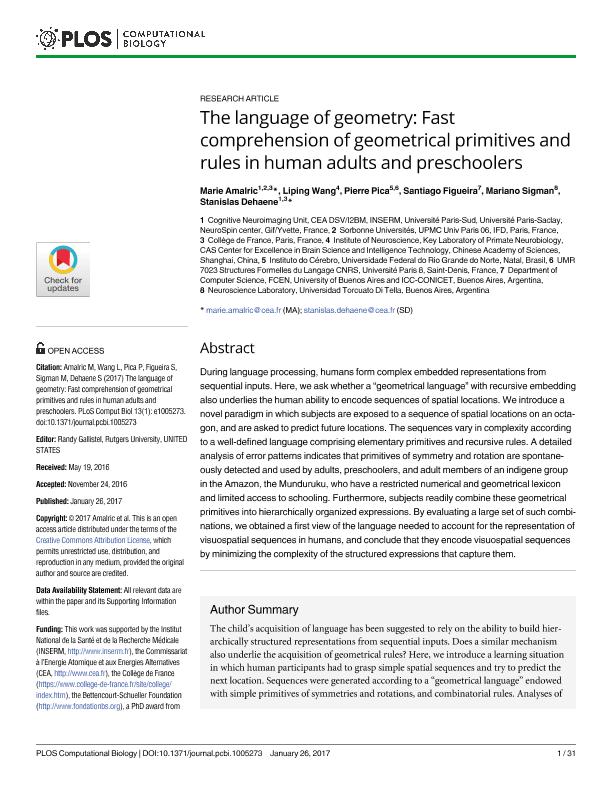Mostrar el registro sencillo del ítem
dc.contributor.author
Amalric, Marie
dc.contributor.author
Wang, Liping
dc.contributor.author
Pica, Pierre
dc.contributor.author
Figueira, Santiago

dc.contributor.author
Sigman, Mariano

dc.contributor.author
Dehaene, Stanislas

dc.date.available
2018-08-02T21:27:40Z
dc.date.issued
2017-01
dc.identifier.citation
Amalric, Marie; Wang, Liping; Pica, Pierre; Figueira, Santiago; Sigman, Mariano; et al.; The language of geometry: Fast comprehension of geometrical primitives and rules in human adults and preschoolers; Public Library of Science; Plos Computational Biology; 13; 1; 1-2017; 1-31; e1005273
dc.identifier.uri
http://hdl.handle.net/11336/54004
dc.description.abstract
During language processing, humans form complex embedded representations from sequential inputs. Here, we ask whether a “geometrical language” with recursive embedding also underlies the human ability to encode sequences of spatial locations. We introduce a novel paradigm in which subjects are exposed to a sequence of spatial locations on an octagon, and are asked to predict future locations. The sequences vary in complexity according to a well-defined language comprising elementary primitives and recursive rules. A detailed analysis of error patterns indicates that primitives of symmetry and rotation are spontaneously detected and used by adults, preschoolers, and adult members of an indigene group in the Amazon, the Munduruku, who have a restricted numerical and geometrical lexicon and limited access to schooling. Furthermore, subjects readily combine these geometrical primitives into hierarchically organized expressions. By evaluating a large set of such combinations, we obtained a first view of the language needed to account for the representation of visuospatial sequences in humans, and conclude that they encode visuospatial sequences by minimizing the complexity of the structured expressions that capture them.
dc.format
application/pdf
dc.language.iso
eng
dc.publisher
Public Library of Science

dc.rights
info:eu-repo/semantics/openAccess
dc.rights.uri
https://creativecommons.org/licenses/by-nc-sa/2.5/ar/
dc.subject
Language
dc.subject.classification
Ciencias de la Información y Bioinformática

dc.subject.classification
Ciencias de la Computación e Información

dc.subject.classification
CIENCIAS NATURALES Y EXACTAS

dc.title
The language of geometry: Fast comprehension of geometrical primitives and rules in human adults and preschoolers
dc.type
info:eu-repo/semantics/article
dc.type
info:ar-repo/semantics/artículo
dc.type
info:eu-repo/semantics/publishedVersion
dc.date.updated
2018-07-25T13:54:25Z
dc.identifier.eissn
1553-734X
dc.journal.volume
13
dc.journal.number
1
dc.journal.pagination
1-31; e1005273
dc.journal.pais
Estados Unidos

dc.journal.ciudad
San Francisco
dc.description.fil
Fil: Amalric, Marie. Université Paris Sud; Francia. Universite de Paris VI; Francia
dc.description.fil
Fil: Wang, Liping. Chinese Academy of Sciences; República de China
dc.description.fil
Fil: Pica, Pierre. Universidade Federal do Rio Grande do Norte; Brasil. Université Paris VIII; Francia
dc.description.fil
Fil: Figueira, Santiago. Consejo Nacional de Investigaciones Científicas y Técnicas. Oficina de Coordinación Administrativa Ciudad Universitaria. Instituto de Investigación En Ciencias de la Computación. Universidad de Buenos Aires. Facultad de Ciencias Exactas y Naturales. Instituto de Investigación En Ciencias de la Computacion; Argentina
dc.description.fil
Fil: Sigman, Mariano. Universidad Torcuato Di Tella; Argentina. Consejo Nacional de Investigaciones Científicas y Técnicas; Argentina
dc.description.fil
Fil: Dehaene, Stanislas. Université Paris Sud; Francia. Collège de France; Francia
dc.journal.title
Plos Computational Biology

dc.relation.alternativeid
info:eu-repo/semantics/altIdentifier/doi/http://dx.doi.org/10.1371/journal.pcbi.1005273
dc.relation.alternativeid
info:eu-repo/semantics/altIdentifier/url/http://journals.plos.org/ploscompbiol/article?id=10.1371/journal.pcbi.1005273
Archivos asociados
